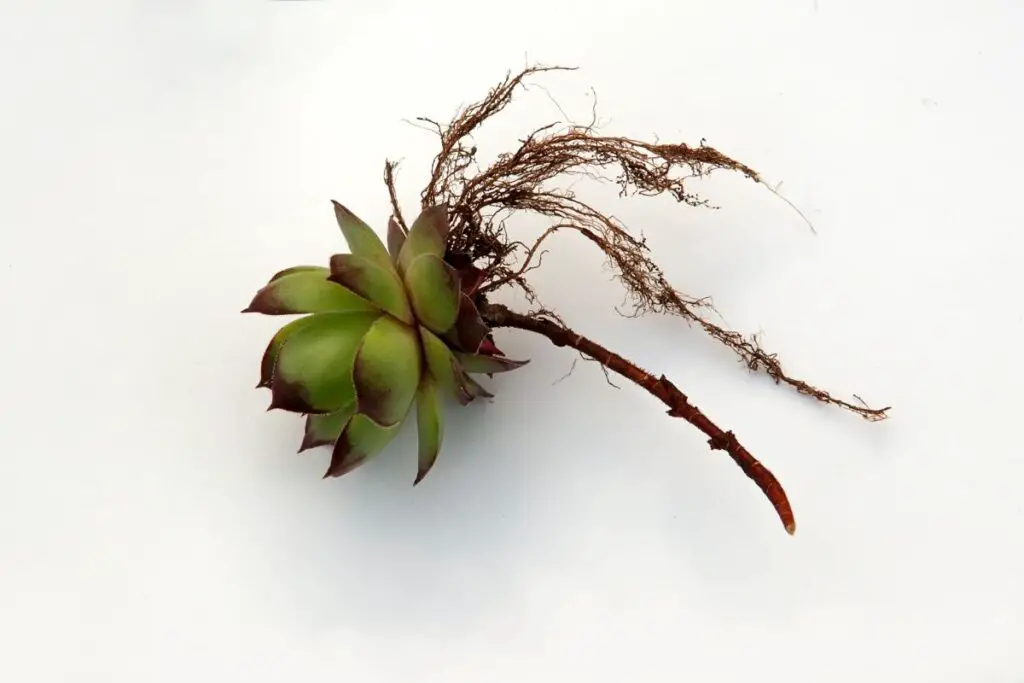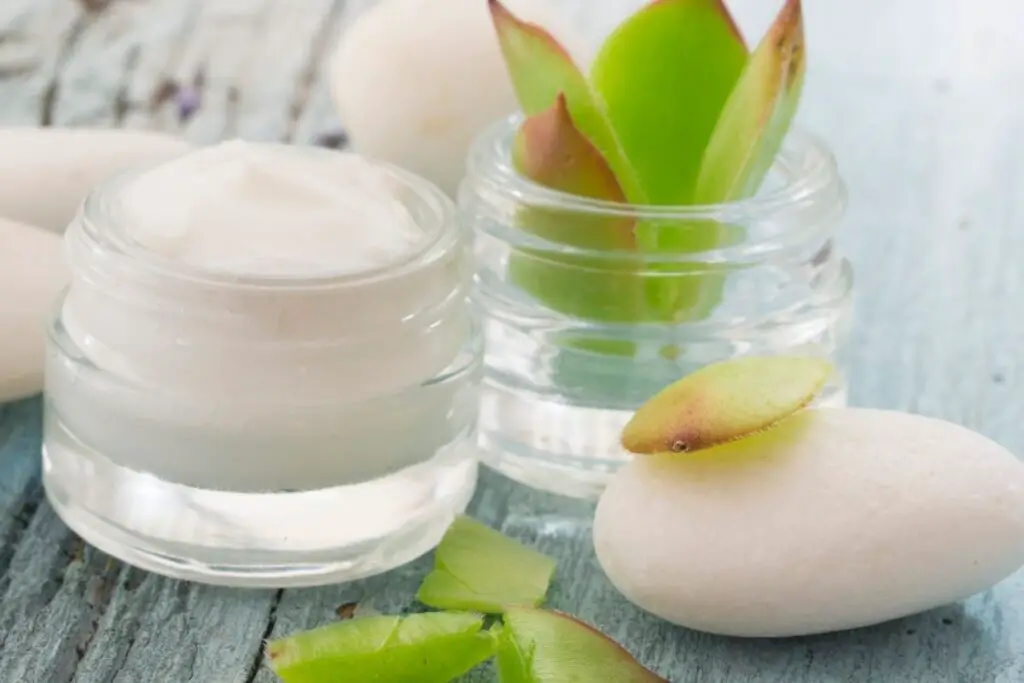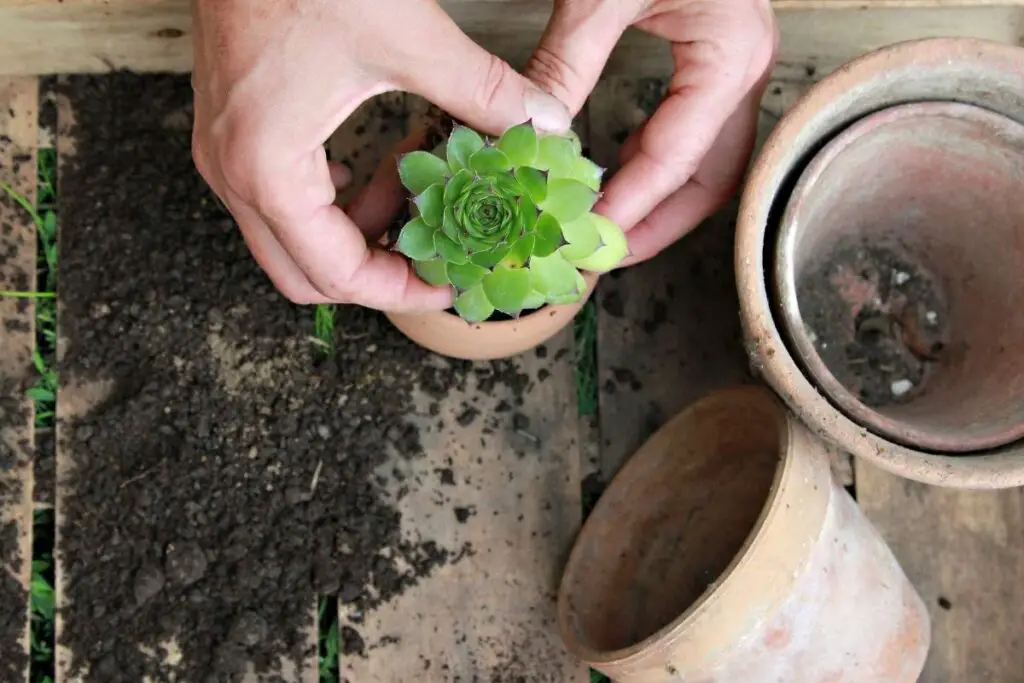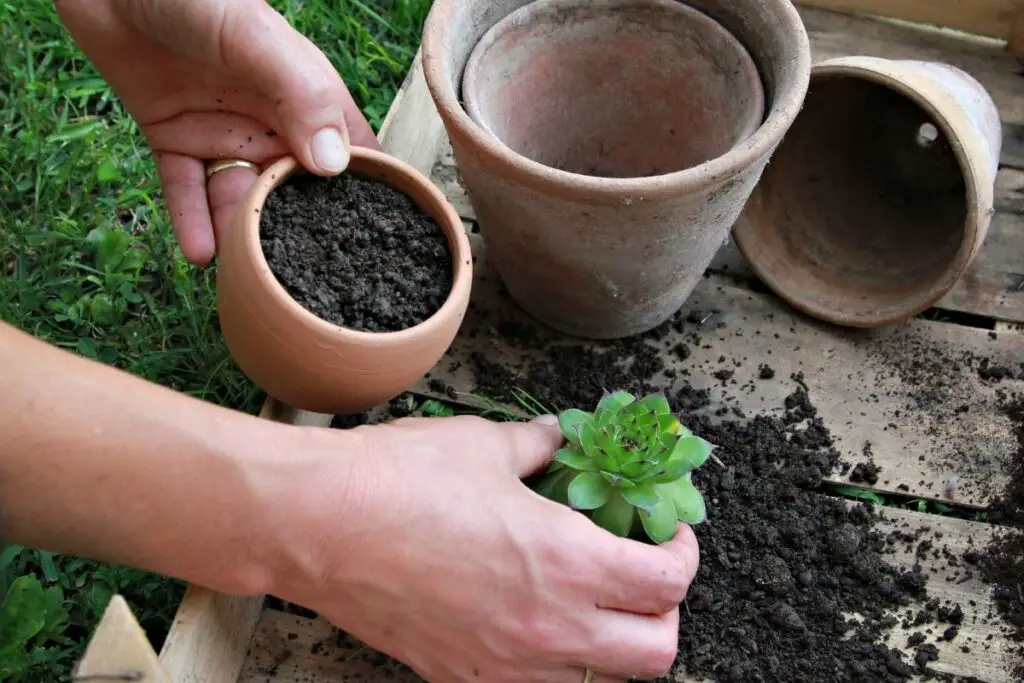Hens and Chicks are drought-tolerant succulents found in many gardens. They can hold moisture in their thick, broad leaves and stems. Having them gives you the chance to get more plants with minimal effort.
But a common question that comes to everyone’s mind is can hens and chicks grow in water?
Hens and Chicks can be grown in water, but it is recommended to move them to the soil once they root. They do not root in water just by leaf-cutting, so you need to divide the chicks and put them in water to root. Also, remember to change the water frequently to prevent rot.
Rooting Hens and Chicks in water gives you a different experience and makes your interior look better. This article will answer can Hens and Chicks grow in water and all the relevant details, so keep reading.
Can you root hens and chicks in water?

Very few succulents can be rooted in water. Hens and Chicks are one of them. Other types of succulents are Echeveria, Jade, Wandering Jew, and Aeonium.
Growing Hens and Chicks in water can be very exciting. Hens and Chicks will not work if you try to propagate them from the leaf-cutting. Doing this will result in dried leaves and no root development.
The best way to succeed in water propagation for Hens and Chicks is by dividing the offsets, trimming the stem, and placing them in water.
Things to keep in mind while growing Hens and Chicks in water
Many factors require consideration when you plan to grow these succulents in water. Before you start propagating, keep the following things in mind. Cultivating Hens and Chicks will be easy and successful.
The size of the plant
Before you divide the baby plants from the mother plant, you must know the ideal size of the offsets capable of dividing and propagating. For healthy growth, you need to choose a healthy plant.
Generally, when the baby plant measures 1-inch in diameter, they are ready for dividing. The bigger the plant is, the more it will endure division and transplantation.
Mainly the large varieties produce more significant offsets than the miniature varieties. So, it would be best to select the large varieties.
The time of separation
Always divide the baby plants during the spring or summer seasons. It is their growing season.
Dividing the baby plants during their growing season helps them vigorous growth in the water. It will also help them recover from transplant or division shock quicker.
Use distilled water or rainwater
Tap water consists of a lot of chlorine, fluorine, and bicarbonates. If you try growing Hens and Chicks in chlorinated water, they will not root well.
Instead, it will deteriorate their health, and they won’t grow any roots. The new leaves will start browning at the edges even if they grow.
Use water that is free from hard minerals. It includes distilled water, rainwater, spring water, water from borewells and wells, and even RO water.
Despite the hard mineral issues, if you are still determined to use tap water or don’t have other options, let the water sit for 24-48 hours.
All the minerals will get removed from the water and evaporate into the air within this time. After that, you can use them.
Don’t try leaf cuttings
Many gardeners recommend propagating Hens and Chicks by leaf cutting. You will find a lot of videos on YouTube too.
But, in most cases, it doesn’t work successfully. The leaves don’t develop any roots, and the leaves begin to dry in no time.
You should divide the offsets to enjoy them rooting successfully in water.
Looking for gardening supplies? We have tested 100's of products before recommending them to you guys. Check out our best pick below:
| Image | Gardening Supplies | Best Price? |
|---|---|---|
 Top
Top Top
Top | Raised Garden Bed Kit | Check On Amazon |
 | XLUX Soil Moisture Meter, Plant Water Monitor, Soil Hygrometer Sensor for Gardening, Farming, Indoor and Outdoor Plants, No Batteries Required | No Results |
 Top
Top Top
Top | 82 Pcs Garden Tools Set and Extra Succulent Tools Set | Check On Amazon |
 | Joeys Garden Expandable Garden Hose with 8 Function Hose Nozzle, Lightweight Anti-Kink Flexible Garden Hoses, Extra Strength Fabric with Double Latex Core, (50 FT, Black) | No Results |
 Top
Top Top
Top | Dual Chamber Compost Tumbler | Check On Amazon |
 Top
Top Top
Top | Sunnyglade Plant Stakes | Check On Amazon |
 Top
Top Top
Top | Organic Cold Pressed Neem Seed Oil | Check On Amazon |
 Top
Top Top
Top | Mighty Mint Gallon :-Insect and Pest Control Peppermint Oil | Check On Amazon |
 Top
Top Top
Top | Scotts DiseaseEx Lawn Fungicide | Check On Amazon |
 Top
Top Top
Top | Jacks Classic 20-20-20 All Purpose Fertilizer | Check On Amazon |
 Top
Top Top
Top | 30,000 Seeds Pollinator Attracting Wildflower Mixture | Check On Amazon |
 Top
Top Top
Top | Survival Vegetable Seeds Garden Kit-Over 16,000 Seeds | Check On Amazon |
Allow the cut ends to develop callous
It means allowing them to heal. After separating the baby plants from the mother plant, you will see that the stems are long enough. You have to trim them off a little.
When you cut them, they will require recovery. Give them time to heal by putting them in a hot climate for 2 days and then in a cold environment for 4-5 days.
Allowing them to form callus gives them the capability to remain strong. It stops them from absorbing and retaining too much moisture. It also prevents the risk of rotting.
Use a clean glass or transparent jar or vase
If you want to grow Hens and Chicks in water, select a clean, transparent container to keep them. Ensure to wash the container properly with soap before placing the plant in it. It ensures the death of fungus and bacteria.
By using a transparent container, like a glass jar or vase, you can keep an eye on the plant roots and water condition. You can see whether the plant is rooting, whether its growth is good or bad.
Using such a container will let you watch the water level and condition. The water should not go above the stem. When the water starts turning cloudy, change it.
How to grow Hens and Chicks in water?

Growing Hens and Chicks in water doesn’t need much effort. It is effortless and comforting.
Tools required:
- A sharp, sterilized knife or pruner
- A transparent jar or vase
- A mature plant from which you need to separate the offsets
- Distilled water or rainwater
Step-by-step guide:
Let’s learn the steps one by one.
Select the plant
Choose a mature and healthy Hens and Chicks plant. The more mature and healthy the plant is, the better the baby plant will root, endure, and fight difficulties.
The offset must be at least 1-inch. If it is smaller than this, it will suffer transplant shock.
If you want to separate the smaller ones before they reach their ideal size, I recommend removing them in clusters. They might not root well because of too small size.
Separate the baby from the mother plant
Slowly pull the small plants from the mother plant. Don’t be rough, as that can damage their stems and rosettes. Remove the dead leaves from the plant’s base.
Prune the stems to prepare them

It will expose more stems after taking the plant out of the mother plant and removing the withered pieces from its bottom. Now, cut the stem about some inches. The plant must have leaves with 1 inch of stem.
After dividing and cutting, you need to give them time to form callous. It will ensure their recovery after placing in water.
If you ignore this callous forming part, your plant will absorb and hold water for a long time. It further makes the plant susceptible to rotting.
Take the container of your choice.
Though you can use any jar of your choice, you can witness the condition of the roots, water, and water level by using a glass jar.
Fill the container with water and place your Hens and Chicks in it. Don’t submerge the entire stem.
The water level must be below the stem. It will prevent the rotting of the plant.
What will you do if the stem is cut too short? Don’t worry. Cover the jar with plastic and seal it. Make a small hole at the center and place the stem inside it.
Doing this has two advantages:
- The plant will have a perfect balance on the edge of the jar.
- It will ensure that only the bottom of the stem sits on the water.
Place the jar at a sunny location
Now keep the jar at a bright spot. A place near the window sill or partially shaded porch would be great. Wait until the roots develop.
The location should be bright enough but shouldn’t receive full sun or direct sunlight.
These plants have not grown any roots yet. Exposing the young Hens and chicks to direct sunlight will burn the foliage and affect their health. Soon, the plant will get stressed by sunburn. In severe cases, die.
It doesn’t mean that Hens and Chicks won’t need direct sunlight if grown in water. You will have to shift them to a fully sunny spot when they develop roots.
Once they grow roots, they will get established and strong enough to handle sunlight. Hens and Chicks will need this light for juicy, broad leaves with colorful rosettes.
Also read: How Much Sun Do Hen And Chicks Need? (Light Requirement)
Change the water regularly
Consider changing the water every 2-3 days. Hens and Chicks will not develop roots if the water is dirty.
Moreover, changing the water ensures that the water remains clear and pure and doesn’t form any algae. Good water quality will speed up their rooting.
How much time will Hens and Chicks take to grow roots in water?

As a general rule, the Hens and Chicks baby plant will take 2-6 weeks to develop roots. But the growth rate of the plant depends on their surrounding climate and environment.
If their growing environment is correct, they will take around 6 weeks. Otherwise, they will take much more time.
If you want to stop them from delayed root growth, check the jar frequently from time to time to keep a watch on the root condition.
Make sure the water level is enough to submerge only the stem bottom. It shouldn’t dry up.
What are the advantages of growing Hens and Chicks in water?
Most people love to have Hens and Chicks because they need the least of your attention.
They don’t require much water because they hold moisture in their leaves and stems. They can thrive easily on sandy soil.
Beyond these, there are many other advantages of growing Hens and Chicks. Similarly, there are many advantages of growing Hens and Chicks in water:
- The process is easy and quick. You only need water and a jar as practical tools.
- It is an easy process for beginners.
- In the present time, if you have a great desire to grow Hens and Chicks but don’t have soil, you can grow them in water.
- There is no risk of overwatering.
- Hens and Chicks will not rot while growing in water.
The main reason behind Hens and Chicks rotting in the soil is due to the presence of pathogens and fungal infections. It happens mostly when the substrate remains wet for a long time.
But when you grow Hens and Chicks in water, they don’t get exposed to any such pathogens. Thus, there is no such risk of rotting.
What are the disadvantages of growing Hens and Chicks in water?
Despite having so many pros, there are still some demerits of Hens and Chicks water rooting:
- It needs a frequent change of water every 2-3 weeks. It leads to wastage of water.
- Changing water more often will require taking out the plant frequently. It can disturb their development.
- When grown in water, there are risks of algae formation. The risk increases when you don’t change the water regularly.
Can I keep the Hens and Chicks in water after rooting, or should I shift them to the soil?

Most people prefer transferring them from the water to the soil after root development. They even say that the root development in the soil is quite different from water rooting.
So, when you shift them to the soil, remember it will take time to get adjusted to the new growing conditions.
However, Hens and Chicks stay and continue growing in water at ease. If you enjoy their look in the water, let them stay there. Change the water regularly every few days.
Also read: What Kind Of Soil Do You Use For Hens And Chicks? (+Best Soil Mix)
Final thoughts on Hens and Chicks water growth
Like soil growth, Hens and Chicks will grow seamlessly in the water. Growing Hens and Chicks in water needs much less effort than soil growth.
You cannot propagate Hens and chicks by stem or leaf cuttings. Divide the baby plants from the mother Hen, trim off some stems and place them in a jar filled with water. Place them under indirect sunlight.
Once they root, shift them to direct sunlight. Change the water regularly and don’t fertilize.
It is excellent for beginners. Growing them in water gives an entirely different experience and look.
FAQs
Can hens and chicks grow without soil?
Yes. Hens and Chicks will grow without soil if rooted in water. But if you want to grow them in the garden, pot, gravel beds, or rock slabs, at least a small amount of soil is needed.
Soil is the basis of the plant’s proficiency to grow because they will get water and nutrients from the soil only.
Can Hens and Chicks be a houseplant?
Hens and Chicks will grow easily both indoors and outdoors. They are easy-to-grow plants and don’t need much of your attention to thrive. They will look great in containers as houseplants and can give your room a pretty look.
Reference: Wikipedia, Iowa State University of Science and Technology, The University of Arkansas Division of Agriculture, NSDU, The Ohio State University, Missouri Botanical Garden.
